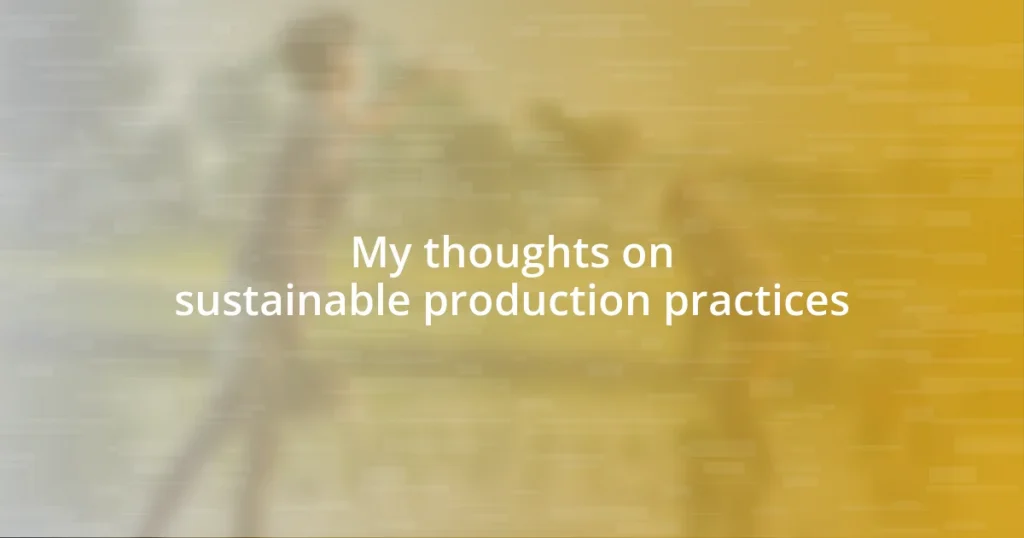Key takeaways:
- Sustainable production practices minimize environmental impact while promoting economic viability and social equity, fostering healthier communities and innovation.
- Core principles include resource efficiency, lifecycle thinking, and fair labor practices, emphasizing the importance of community engagement and transparency.
- Future trends involve integrating digital technology, adopting regenerative practices, and embracing a circular economy to redefine product lifecycles and reduce waste.

Understanding sustainable production practices
Sustainable production practices focus on minimizing negative impacts on the environment while ensuring economic viability and social equity. Think about it: when we choose to produce goods with renewable resources and sustainable materials, we’re not just protecting our planet; we’re also fostering healthier communities. I often find myself reflecting on the products I buy and realizing how my choices can either contribute to or diminish this ideal.
In my experience, sustainable production isn’t merely a trend; it’s a mindful shift in how we approach manufacturing. I remember visiting a local artisan workshop where every piece was crafted from recycled materials. Witnessing the passion in the artisans’ eyes made me realize that sustainable practices aren’t just beneficial for the environment—they bring people together. This realization prompted me to rethink my own consumption patterns.
What if we all made small changes in our production choices? By opting for practices that prioritize sustainability, we can significantly reduce waste and pollution. It feels empowering to know that each decision, no matter how small, can lead to a larger positive impact on our world. Understanding these practices deeply resonates with me, as I believe creating a harmonious balance between production and preservation is essential for future generations.

Importance of sustainable production
Sustainable production is crucial because it fosters a healthier relationship between industry and the environment. I recall a hiking trip where I stumbled upon a beautifully preserved natural area, which made me think about how unsustainable practices are, unfortunately, stripping such places away. By adopting sustainable production methods, we can preserve more of these treasures for future generations, allowing us to enjoy the natural beauty that so many overlook.
Engaging in sustainable production practices also stimulates innovation. One time, while attending a workshop on sustainable technologies, I learned about a company that turned food waste into biodegradable packaging. The excitement in the room was palpable, as we all realized that what may seem like a problem could transform into an opportunity. This not only aligns with environmental goals but also opens pathways for economic growth and job creation.
The social implications are equally important. When companies prioritize sustainable production, they often support fair labor practices. I vividly remember volunteering with an organization that partners with local suppliers, ensuring they receive fair compensation while promoting sustainable practices. The pride in their work was evident, and it reinforced my belief that when we value people alongside the planet, we create stronger, more resilient communities.
| Aspect | Importance of Sustainable Production |
|---|---|
| Environmental Protection | Helps preserve natural resources and reduce pollution |
| Innovation | Encourages new technologies and sustainable solutions |
| Social Equity | Supports fair labor practices and builds community ties |

Key principles of sustainable production
Sustainable production hinges on several key principles that guide practices toward a more responsible and ethical framework. I’ve always been inspired by the idea that sustainability means not just doing less harm, but actively doing good. For instance, I once joined a community garden initiative that educated locals on permaculture—a method that utilizes natural ecosystems to grow food sustainably. It was enlightening to see how principles like resource efficiency and waste minimization can foster both environmental health and community resilience. Here are a few core principles that stand out:
- Resource Efficiency: Utilizing materials judiciously to minimize waste and energy use.
- Lifecycle Thinking: Considering the environmental impact of a product from raw material extraction to disposal or recycling.
- Renewable Resources: Prioritizing materials that can be replenished naturally, such as bamboo or recycled metals.
Another critical principle is social responsibility, which I find deeply resonates with me. While volunteering at a local eco-festival, I encountered small businesses focused on ethical sourcing. Hearing the stories behind their products reminded me of how vital it is to support those who prioritize people and planet over profit. It was a real eye-opener for me, reinforcing the idea that sustainable production can indeed uplift communities. Key tenets include:
- Fair Labor Practices: Ensuring workers receive fair wages and safe working conditions.
- Community Engagement: Actively involving local communities in the decision-making process, creating shared benefits.
- Transparency: Being open about sourcing and production methods, allowing consumers to make informed choices.
By embracing these principles, we can create a production landscape that nurtures our world and its inhabitants, making every step in the process a step toward a healthier future.

Strategies for sustainable production
One effective strategy for sustainable production is the integration of circular economy principles. I remember attending a seminar where a speaker discussed how companies can design products to be reused or recycled. It made me think, why are we still creating things that end up in landfills? Emphasizing a circular model not only reduces waste but also encourages innovation in product design. Companies that embrace this approach often discover new value streams, like taking back old products to refurbish or repurpose them.
Another tactic I’ve come to appreciate is the use of technology to enhance sustainability. For instance, when I visited a local manufacturing plant, they showcased a real-time monitoring system that tracks energy consumption. I was truly impressed—this technology not only minimizes waste but also boosts operational efficiency. Could this be the future of all production? By adopting smart technologies, businesses can significantly reduce their carbon footprints, making sustainability a core part of their operation.
Moreover, ongoing education and collaboration within industries can amplify the impact of sustainable practices. During a discussion at a sustainability-focused conference, I felt inspired by professionals sharing their successes and challenges. It struck me that knowledge sharing can propel us all forward. Wouldn’t it be great if every company invested in learning from peers? Cultivating a culture of continuous improvement and collective effort has the potential to drive significant advancements in sustainable production across various sectors.

Benefits of implementing sustainable practices
Implementing sustainable practices can lead to significant cost savings for businesses. I recall a friend who runs a small textile company. After transitioning to eco-friendly materials and energy-efficient machinery, she not only reduced her utility bills but also saw a boost in sales as consumers increasingly favored sustainable fashion. Isn’t it fascinating how something as simple as mindfulness about resource use can lead to both financial and environmental benefits?
Moreover, adopting sustainable practices often enhances a brand’s reputation. I’ve experienced this firsthand when I started supporting brands that prioritize sustainability. It felt good knowing my purchases were contributing to a better future. Customers nowadays are much more discerning; they want to align their values with the companies they support. So, from my perspective, businesses that commit to sustainability tend to foster greater loyalty and trust within their consumer base. Isn’t that a win-win situation?
In addition to these benefits, sustainability can also drive innovation. I remember attending a workshop where a startup showcased their biodegradable packaging solutions. Hearing their journey inspired me; they were solving real-world problems in such creative ways! When companies embrace sustainable practices, they often find themselves exploring new technologies and methods, pushing the boundaries of what’s possible. It makes me wonder—what innovative solutions are just waiting to be discovered by those willing to shift their focus towards sustainability?

Case studies of successful practices
One powerful example of successful sustainable production practices can be found in Patagonia, the outdoor apparel company. I was struck by their commitment to transparency and repairs; they encourage customers to send back worn items for repair, even sharing tutorials on how to fix gear at home. Isn’t it incredible to think about a brand that not only sells products but also invests in their longevity? This practice reinforces not just sustainability but also a sense of community among consumers who value long-lasting gear.
Another remarkable case study is that of Interface, a flooring company that has made significant strides toward sustainability by adopting a mission called ‘Mission Zero.’ Their aim was to eliminate any negative impact they have on the environment by 2020. Reflecting on this, I’m amazed at how dedicated they were to reducing carbon emissions and utilizing sustainable materials. They’ve even transformed old carpet tiles into new products, creating a demand for circularity. Isn’t this what we need from more companies—foresight and commitment to doing better for the planet?
On a smaller scale, I recently came across a local coffee shop that practices waste reduction through composting and sourcing beans from eco-friendly farms. The owner shared how the extra effort has not only drawn in environmentally conscious customers but created a warm, inviting community atmosphere. It made me think—can local businesses be the spark for larger societal changes? These examples vividly demonstrate that sustainable practices don’t just create a better world; they can redefine brand identity and community engagement.

Future trends in sustainable production
Looking ahead, I see a notable trend toward integrating digital technology in sustainable production practices. For instance, businesses are increasingly using data analytics to optimize resource management and reduce waste. When I first heard about companies employing AI to forecast demand accurately, I was blown away by the potential to avoid overproduction. Isn’t it exciting to think that technology can align with eco-friendly goals?
I’m also noticing a shift towards regenerative practices, which aim to restore ecosystems rather than merely sustain them. A friend who runs an organic farm recently embraced this idea, and the difference in soil health and biodiversity has been astounding. It made me wonder—what if all industries adopted this mindset? The future could see a transformation where companies actively contribute to the health of our planet while meeting their production needs.
Finally, the rise of the circular economy is set to redefine how we think about products at the end of their life cycle. Instead of viewing waste as discarded materials, innovative companies are finding ways to recycle and repurpose items. I remember visiting a workshop where entrepreneurs shared their passion for turning plastic waste into fashionable accessories. It’s a testament to human creativity! The question is, how far will we go in embracing this future where nothing truly goes to waste?















